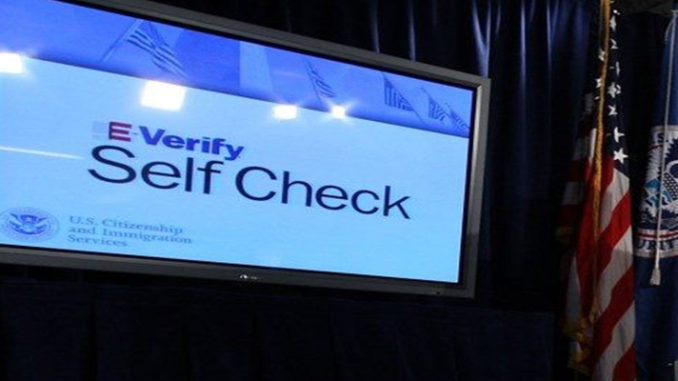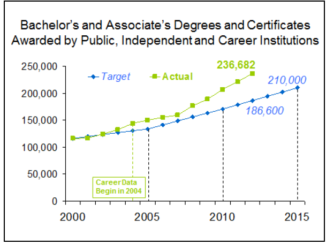
It can’t succeed — and no one wants it to anyway.
by Alex Nowrasteh
Politicians of all stripes have rallied around the federal government’s E-Verify system as a low cost and effective way to keep undocumented immigrants out of the United States. Congress needs to reauthorize E-Verify this fall when funding for the government runs out. Between now and then, members of Congress need to take a serious look at this failed program.
E-Verify is a database system that checks identities of newly hired workers against government records. Employers are supposed to fire new employees if the system flags them as being in the United States illegally. In this way, the program is supposed to turn off the jobs magnet that attracts undocumented immigrants in the first place. Proponents of the system believe that without the jobs magnet, illegal immigration would stop.
E-Verify’s theoretical simplicity is one reason why it was initially so popular in some southern states and Arizona. If a quick computer check could accurately tell whether a worker is an undocumented immigrant then workplace raids, mass roundups of undocumented immigrants and a massive deportation force becomes unnecessary. Most would just self-deport, in the famous words of Sen. Mitt Romney, while he was a presidential candidate in 2012.
That’s the theory anyway. In reality, three groups of people—workers, companies and even the politicians who trumpet it—have come together to ensure that E-Verify remains completely powerless.
Congress has not mandated E-Verify nationwide, but states have been experimenting with it as an immigration enforcement tool for more than a decade. In these cases, state-level employers were required to run the identity information provided by new hires through the online E-Verify website, then wait for government permission to keep the worker on the payroll.
The first state to mandate E-Verify for all new hires was Arizona in 2008. Former Arizona Republican state Sen. Rich Crandall said E-Verify “was promised as the silver bullet to immigration problems. E-Verify was going to solve our challenges with immigration.” Terrified by the prospect of an effective E-Verify program, about 17 percent of Arizona’s undocumented immigrant population left the state in response to its implementation.
But the exodus slowed after E-Verify went into effect because workers and businesses figured out how to get around it. Those lessons quickly spread to the other states where E-Verify was mandated, like Mississippi , whose undocumented immigrant population has remained roughly constant for a decade.
In August, Immigration and Customs Enforcement agents raided several meat processing plants in Mississippi and detained 680 undocumented immigrant workers, eventually letting 300 go. If E-Verify was the silver bullet program sold to state legislators like Rich Crandall, then ICE raids should not have been necessary, as undocumented immigrants would never have been employed in the first place.
Undocumented immigrant workers get around E-Verify mandates in several ways. The first is by taking advantage of E-Verify’s biggest weakness: It checks the identification papers, not the worker. Thus, an undocumented immigrant worker can pass an E-Verify check if he hands somebody else’s identification to his employer. According to an audit for the federal government conducted by Westat, about 54 percent of undocumented immigrant workers are approved to work by E-Verify for this very reason.
The workers sometimes steal IDs, but many also borrow them from friends or family members. The story of a young undocumented immigrant named “Manuel” explains how so-called identity loans work. Manuel needed identification to work in the unionized construction industry in San Francisco. He contacted an uncle in Mexico who had obtained a Social Security number in the early 1970s but then returned to Mexico permanently. The uncle let Manuel use his SSN and forge a new green card with his uncle’s name. Since there is no victim of this kind of fraud, identity loans are extremely difficult to stop.
But workers aren’t the only ones who have figured out how to fool E-Verify — many businesses are also adept at doing so. The easiest way is to just not use E-Verify. In Mississippi, for instance, only about half of all new hires were even run through the system even though 100 percent were supposed to be cleared. E-Verify use rates in the other states where it’s mandated aren’t much better.
Many employers use E-Verify but look the other way. Their job is not to inspect documents, which can open them up to potential discrimination claims, but they are often not interested in doing so anyway. Many of the hires in Mississippi actually were wearing ICE ankle bracelets – a sign that they had entered the country illegally and were awaiting a deportation hearing and theoretically should not have been permitted to work. One undocumented immigrant worker with an ankle tracking device after the Mississippi raids said that she’s waiting for everything to “go back to normal” because then a company may take her on again.
Businesses have every reason to avoid E-Verify. So far, no executives have been charged by the federal government for illegally employing workers. States rarely enforce E-Verify mandates against businesses – which brings us to the third group that doesn’t want E-Verify to work: politicians.
E-Verify allows politicians to have it both ways: Supporting it makes them look tough on illegal immigration while the fact that it’s so easy to evade means their local businesses and economies are largely unaffected. Thus, politicians who support E-Verify get the political benefits without their constituents paying the economic costs. (Undoubtedly, there are some politicians who support E-Verify because they think it will work, but conviction is greater when principle is cheaper.)
Mississippi isn’t the only state where E-Verify has failed. In an infamous series of raids in 2006, ICE arrested nearly 1,300 workers at Swift & Co. meatpacking plants across the Midwest – all of whom had passed E-Verify checks. How many more raids need to happen before lawmakers realize that E-Verify is not the silver bullet they were promised?
E-Verify simply does not work. Its systematic design flaws make the program destined to fail. Congress has never seriously debated E-Verify – its reauthorization by this November provides a golden opportunity to reexamine this program in light of all of its failures. Fixing the legal immigration system by allowing more low-skilled workers on temporary visas and green cards will remove the need for E-Verify entirely. After all, if workers can come legally then they won’t come illegally.
That’s the only way for Congress to permanently fix the problem of illegal immigration. In the meantime, Congress should scrap E-Verify, stop pretending the system could ever work and go back to the drawing board.
Alex Nowrasteh is director of immigration studies at the Cato Institute,



